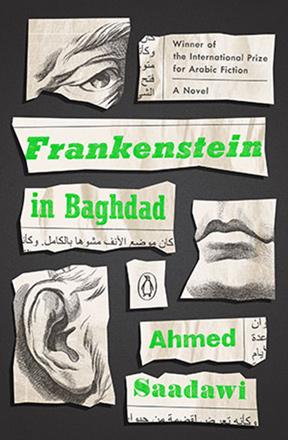You are here
Urban legend or real?
By Sally Bland - Aug 26,2018 - Last updated at Aug 26,2018

Frankenstein in Baghdad
Ahmed Saadawi
Translated by Jonathan Wright
New York: Penguin Books, 2018
Pp. 281
From Mary Shelley’s 1818 classic novel, “Frankenstein”, Iraqi writer Ahmed Saadawi plucks a metaphor for the situation of his war-torn country. The Frankenstein in Saadawi’s novel is not a scientist but a junk dealer, and the metaphor describes the physical, political and social fragmentation of Iraq, engineered by the 2003 invasion and post-war US policy, as well as the ensuing sectarian violence.
The story opens two years after the invasion, in Baghdad, “a troubled city where the demons had broken out of their dungeons and come to the surface all at once”. (p. 64)
The truly unsettling thing is that no one knows exactly who these demons are, or who is behind the daily car bombs and other forms of explosions and violence — some targeted and some seemingly random. Saadawi does a masterful job of creating the atmosphere of fear and terror that prevails and showing how it impacts on the human psyche: What does it mean for human behaviour if one does not know whom to trust or what will happen next?
The heart of the story unfolds in a neighbourhood which may once have been respectable, but is now crumbling from old age and war, peopled by some unscrupulous characters who take advantage of the chaos to enrich themselves, while most are just trying to survive. One of the latter is Hadi, the junk dealer, who loves to tell stories whenever he can get an audience. He seems like a rather ordinary guy until, after a particularly destructive car bomb, he begins to assemble a corpse. He is initially motivated by outrage: “I wanted to hand him over to the forensics department because it was a complete corpse that had been left in the streets like trash. It’s a human being… I made it complete so it wouldn’t be treated like trash, so it would be respected like other dead people and given a proper burial.” (p. 27)
But what begins as an attempt to redress the devaluation of human life induced by so much violence, soon becomes more complicated as the reconstructed corpse takes on a life of its own, something like Dr Frankenstein’s monster in Shelley’s book. Consisting of dead body parts, it must be constantly replenished as some parts decompose totally and fall off. Soon, terrible new crimes are being committed. What is their motive? Who is responsible? Is it Hadi’s creation, or criminals or terrorists? And who can tell the difference?
The creature sees his mission as avenging the death of the victims of whose body parts he is composed, so that they may rest in peace. Here one sees how the Frankenstein metaphor aptly expresses the self-perpetuating cycle of killing and raises existential questions about the violence that is tearing society apart: The creature “knew his mission was essentially to kill, to kill new people every day, but he no longer had a clear idea who should be killed or why. The flesh of the innocents of which he was initially composed, had been replaced by new flesh, that of his own victims and criminals”. (p. 200)
Eventually, he begins taking revenge on those who insult him, widening the circle of violence. He attracts a following which resembles a cult or gang or militia that perpetuates and glorifies violence. Different followers have different perceptions of the creature. One thinks he is a saviour; another, the Angel of Death; yet another, the model citizen the Iraqi state has so far failed to produce — “made up of body parts of people from diverse backgrounds —ethnicities, tribes, races, and social classes”. (pp. 146-7)
But in the end, he admits he kills simply to keep going. Killing has become a way of life just as in many protracted conflicts where few other jobs are available to the poor.
Steeped in irony, black humour and surreal interludes, Saadawi has created a powerful anti-war novel showing the cruelty, tragedy, destructiveness and ultimate absurdity of war. There are many other characters, themes and subplots; the Frankenstein metaphor is only the most shocking and pervasive. The other most prominent theme is exposing the dangerous consequences of sectarianism. All the elements of literature are carefully crafted into a chilling whole; the very structure of the novel is disorienting, reflecting the security situation.
Saadawi was born in Baghdad and still lives there. Besides his obvious writing skills, this may explain why his story rings so true, even when it tips over into the surreal and fantastic. In 2014, he was awarded the International Prize for Arabic Fiction for this book, which paved the way for its translation into English. A novel about the Iraq war from an Iraqi perspective is a much-needed antidote to all the lies that have accompanied this war. While the creature may be an urban legend, Saadawi’s story is in essence all too real.
Related Articles
BAGHDAD — When Ahmed Saadawi finished writing “Frankenstein in Baghdad”, a dark fantasy about the war that tore Iraq apart a decade ago, he
Memoirs of a Woman DoctorNawal El SaadawiTranslated by Catherine CobhamLondon: Saqi Books, 2019Pp.
Dreams of Maryam Tair: Blue Boots and Orange BlossomsMhani AlaouiUS: Interlink, 2015Pp.














